Explore the avian wonders of California’s backyards with our guide to the most common backyard birds! From the vibrant Western Scrub-Jay to the melodious House Finch, California’s diverse landscapes host a rich array of birdlife.
In this comprehensive guide, we’ll introduce you to the species most frequently seen in California’s urban and suburban areas, providing valuable insights for bird enthusiasts and nature lovers.
Table of Contents
- 1 Most Common Birds In California
- 1.1 House Finch
- 1.2 Black Phoebe
- 1.3 Anna’s Hummingbird
- 1.4 American Crow
- 1.5 Mourning Dove
- 1.6 California Scrub-Jay
- 1.7 Yellow-rumped Warbler
- 1.8 White-crowned Sparrow
- 1.9 California Towhee
- 1.10 Common Raven
- 1.11 Song Sparrow
- 1.12 Lesser Goldfinch
- 1.13 European Starling
- 1.14 Bushtit
- 1.15 Dark-eyed Junco
- 1.16 Spotted Towhee
- 1.17 Northern Mockingbird
- 1.18 American Robin
- 1.19 Bewick’s Wren
- 1.20 Northern Flicker
- 2 Frequently Asked Questions
- 2.1 Are there falcons in Los Angeles?
- 2.2 What is the official bird of California?
- 2.3 Are There robins in Southern California?
- 2.4 Do cardinal birds live in California?
- 2.5 Is there blue Jays in California?
- 2.6 What is the most common bird in southern California?
- 2.7 What are the bluebirds in California called?
- 3 Author
Most Common Birds In California
House Finch
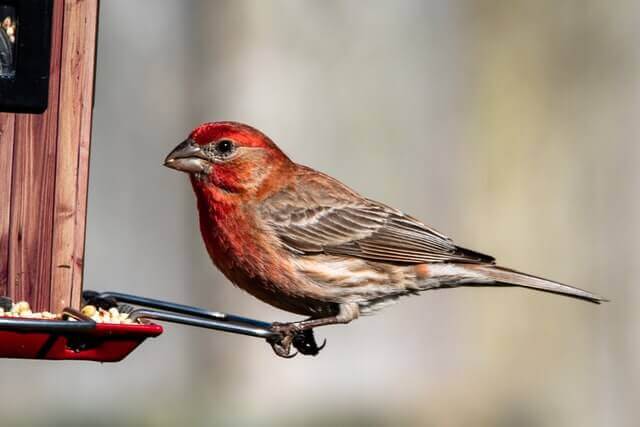
House Finches are medium-sized birds that live in North America. They are common backyard visitors and can be found throughout the United States, Canada, Mexico and parts of Central America. The House Finch is an adaptable bird that prefers areas with trees and brush but also thrives in urban habitats like parks, yards and even on buildings where they nest among window ledges or rooflines.
These birds eat insects, seeds, fruits and berries that they find on the ground while hopping around. They migrate during the winter months to warmer climates in Central America for the breeding season.
- Frequency: 44.02% (Statistic: eBird)
- Color: Reddish face and upper breast, brown streaks on back, belly, and tail.
- Habitat: urban and suburban areas, backyards, edges, yards, and parks
- Range: Canada, USA, Mexico
- Size: 5 – 6″ inches
- Weight: 16 – 27 grams
- Diet: Aphids, grains, seeds, berries, nettle, dandelion, sunflower
- Family: Fringillidae
- Genus: Haemorhous
- Maps: Range Map – Sightings Map
- Sounds: Calls and Songs
Related: How to Attract House Finch to your Yard
Black Phoebe
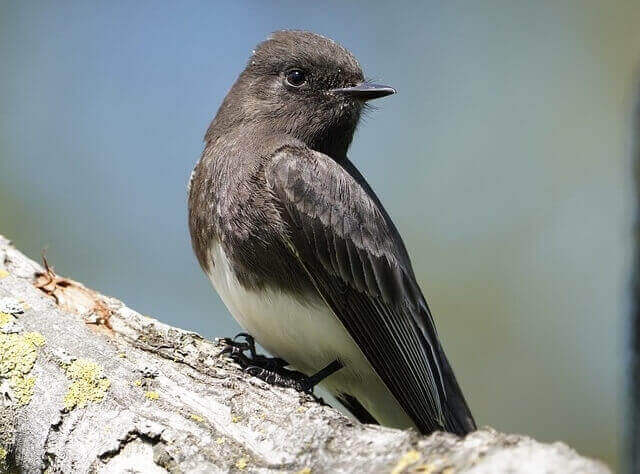
Black Phoebes are migratory birds that breed in North America and winter in Central America. They prefer to live near water, especially on coastlines, but will also inhabit woodlands. Their diet consists of insects and other invertebrates such as earthworms, slugs, snails and beetles.
Their range includes all 50 states of the United States (except for Hawaii) as well as Canada south of the tundra region. Black Phoebes breed primarily from April to July, with males defending territories and females selecting their mates. The Black Phoebe does migrate south for the winter months to avoid harsh weather conditions.
- Frequency: 41.43%
- Color: Has ablack plumage, with white on its belly and under the tail.
- Habitat: Coastal cliffs, river/lake banks, parks
- Range: West and Southwest United States, Mexico, Central America, South America,
- Size: 6.3″
- Weight: 16 – 22 grams
- Diet: Beetles, wild bees, wasps, flies, moths, caterpillars, crickets, grasshoppers.
- Family: Tyrannidae
- Genus: Sayornis
- Maps: Range Map – Sightings Map
- Sounds: Calls and Songs
Anna’s Hummingbird
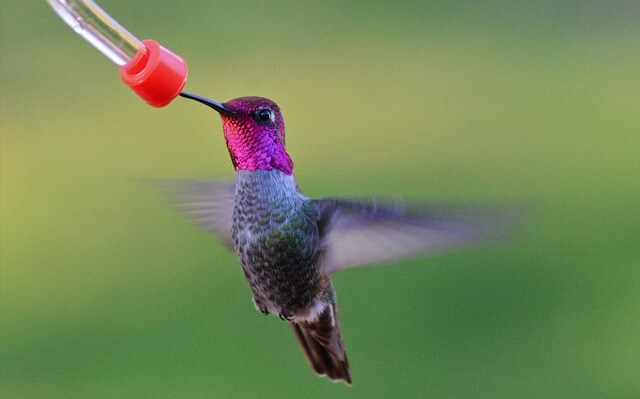
The Anna’s Hummingbird is a medium-sized hummingbird native to the west coast of North America. It can be found in open woodland habitats, chaparral scrubland, deserts, and most coastal areas from Alaska down to northern Mexico, and in the Rocky Mountains as far east as New Mexico. They eat insects such as mosquitoes, flies, beetles, spiders and ants; small invertebrates like caterpillars; nectar from flowers; tree sap; cactus fruit or berries.
Anna’s Hummingbirds are migratory birds that fly south for winter during September or October and return north again in March or April. They have been observed migrating through Canada and Central America, sometimes even crossing the Gulf of Mexico.
- Frequency: 38.91%
- Color: Bronze-green iridescent back, a gray chest and belly, and green flanks
- Habitat: Open woodland, chaparral, coastal scrub, oak savannahs, backyards
- Range: Western coast of North America, Southern Canada, Northern Baja California, Arizona, Nevada, Utah, Texas.
- Size: 3.9 – 4.3″ inches
- Weight: 3 – 6 grams
- Diet: Nectar, flowers, and insects
- Family: Trochilidae
- Genus: Calypte
- Maps: Range Map – Sightings Map
- Sounds: Calls and Songs
American Crow
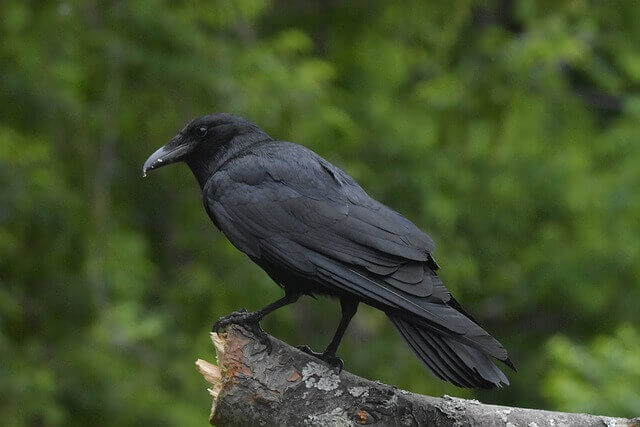
The American Crow is the most common and widespread corvid in North America. These birds are found throughout the continental United States, with populations as far south as Mexico and as far north as Alaska. They are omnivores and will eat anything from insects to small mammals, eggs, fruit, seeds, garbage and carrion.
The American Crow’s diet can vary depending on what they find available near their nest site or where they live during different seasons of the year. They are also found in some areas of South America, and they live in forested, open woodlands, prairies, farmlands, and coastal shores. In winter, it migrates south because it cannot survive colder temperatures due to food natural shortages.
- Frequency: 36.38%
- Color: Black
- Habitat: Open country, farms, parks, woodlands, towns, cities
- Range: Canada, USA, Mexico
- Size: 16 – 21″ inches
- Weight: 315 -620 grams
- Diet: invertebrates, carrion, seeds, eggs fish, grains, mice, frogs, and other small animals.
- Family: Corvidae
- Genus: Corvis
- Maps: Range Map – Sightings Map
- Sounds: Calls and Songs
Related: How To Attract Crows To Your Backyard: Expert Tips!
Mourning Dove
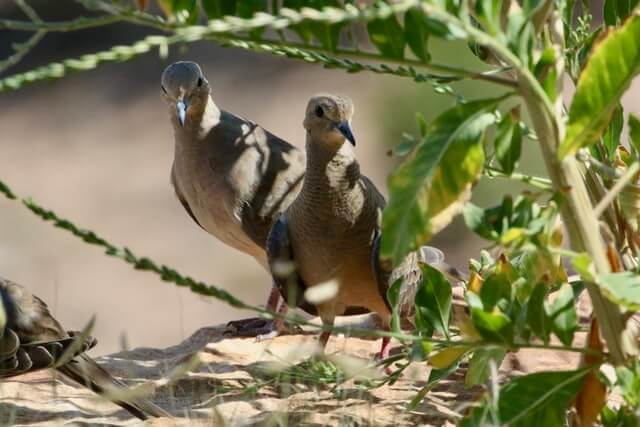
Mourning doves are native to North America and have a widespread range. These birds can be found from coast to coast in the United States, south of Canada, all the way down into Central America. Mourning doves live mostly in open country, but they will also inhabit ranches, meadows and pastures, agricultural areas and forests with scattered trees.
Mourning doves eat a variety of seeds including weed, grasses, and cereal grains as well as fruit such as cherries and wild grapes. Mourning doves migrate south for the winter to escape cold weather, but will return north when warmer temperatures arrive. In North America, mourning doves are most abundant from November through April.
- Frequency: 34.61%
- Color: Light gray-brown and lighter and pinkish below. The wings have black spots.
- Habitat: Open habitats, urban areas, farms, prairie, grassland, wooded area
- Range: USA, Canada, Mexico, Central America, Greater Antilles
- Size: 12″ inches long
- Weight: 112 – 170 grams
- Diet: Rapeseed, corn, millet, safflower, sunflower seeds, pokeberry, sesame, and wheat.
- Family: Columbidae
- Genus: Zenaida
- Maps: Range Map – Sightings Map
- Sounds: Calls and Songs
Related: Facts About Mourning Doves – 10 Things You Need To Know!
California Scrub-Jay
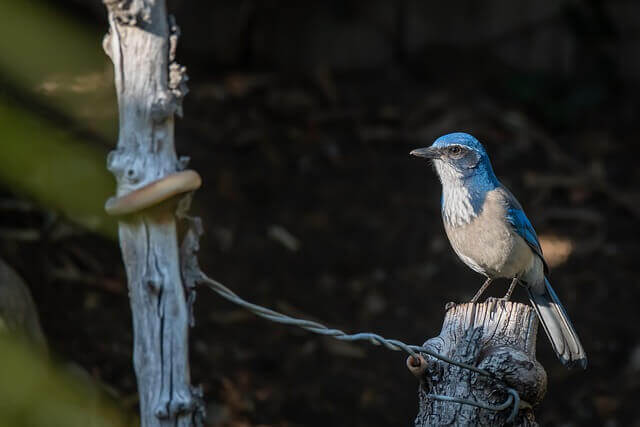
The Scrub-Jay can be found in lowland forests and chaparral habitats throughout southern California, but not north of Point Conception. They can also be found in scrub oak and pine forests from the San Francisco Bay Area to southern Oregon, but not inland or north of the Sacramento Valley.
The diet includes a variety of insects, small vertebrates such as lizards and mice, eggs and nestlings from other birds (especially woodpeckers), fruits, acorns, grasses seeds and berries.
- Frequency: 32.59%
- Color: Blue head, tail, and wings, grayish brown back, grayish underparts, and white eyebrows
- Habitat: suburban gardens, forests, oak woods, edges of mixed evergreen forests, suburban gardens, low scrub
- Range: U.SA, Canada, Mexico, Central America, and the Caribbean
- Size: 11 – 12″ inches long
- Weight: 80 grams
- Diet: Frogs, lizards, eggs, young birds, insects, grains, nuts, berries, fruit and vegetables
- Family: Corvidae
- Genus: Aphelocoma
- Maps: Range Map – Sightings Map
- Sounds: Calls and Songs
Yellow-rumped Warbler
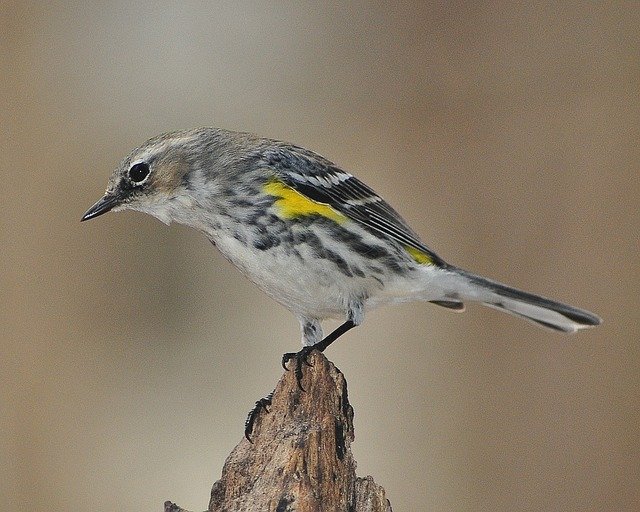
The Yellow-rumped Warbler is a North American tree diving bird species, which is usually found all throughout the continent, at low ground level, below the bark of trees and in deciduous forests, mixed deciduous and coniferous woods, and occasionally grasslands and gardens, fields, along river banks and ditches. In both winter and summer, the male Yellow-rumped warbler can be seen migrating long distances in search of food.
In the fall, they return to their natal areas. During winter, they take shelter in a thick cover of evergreens and deciduous woods. They are omnivores with a diet that includes insects, spiders, fruits and berries; they also feed on sap oozing from trees when necessary.
- Frequency: 30.62%
- Color: Yellow patches on the crown, flanks, rump & blackish-blue streaks on the back, breast, and wings
- Habitat: Deciduous forests and thickets, roadside, grasslands, backyards
- Range: U.SA, Canada, Mexico, Central America, and the Caribbean
- Size: 4.7 – 5.9″ inches long
- Weight: 10 – 18 grams
- Diet: grasshoppers, gnats, aphids, caterpillars, wasps, beetles, spiders, berries,
- Family: Parulidae
- Genus: Setophaga
- Maps: Range Map – Sightings Map
- Sounds: Calls and Songs
White-crowned Sparrow
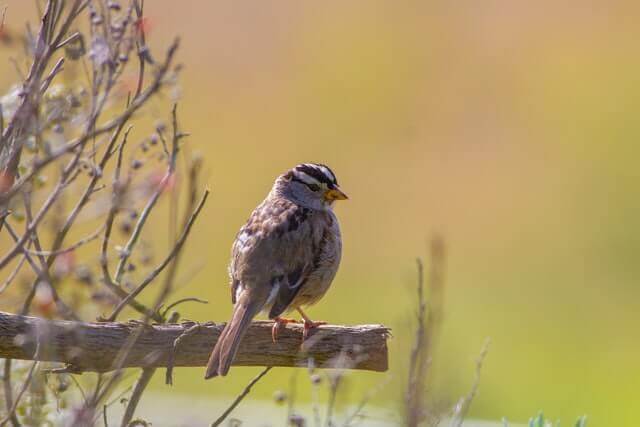
The White-crowned Sparrow is one of the most popular and widely distributed bird species throughout the state. They are common throughout all of central, southern, and eastern California, with the western part of the state having the least number of birds found there. These beautiful birds have a varied diet, ranging from berries, seeds, nuts, and insects to carrion and other animals.
Their natural habitat ranges from coastal mountains to near oceans, providing them with a variety of options for their food. This diet along with the ability to fly and their large wingspan enables these birds to make quick journeys across vast distances. These birds are great winter and summer migrations, migrating long distances to head south for the winter and return in the spring. The habitat ranges from rocky cliffs, low rolling hills to rocky coastlines.
- Frequency: 30.03%
- Color: Black and white stripes on their head, gray face, brown-streaked upper, and a long tail. Brown wings with bars and the underparts are gray.
- Habitat: Brushy areas
- Range: Western USA, and Northern Canada
- Size: 5.9″ – 6.3″ inches long
- Weight: 25 – 28 grams
- Diet: Seeds, insects, and plants
- Family: Passerellidae
- Genus: Zonotrichia
- Maps: Range Map – Sightings Map
- Sounds: Calls and Songs
California Towhee
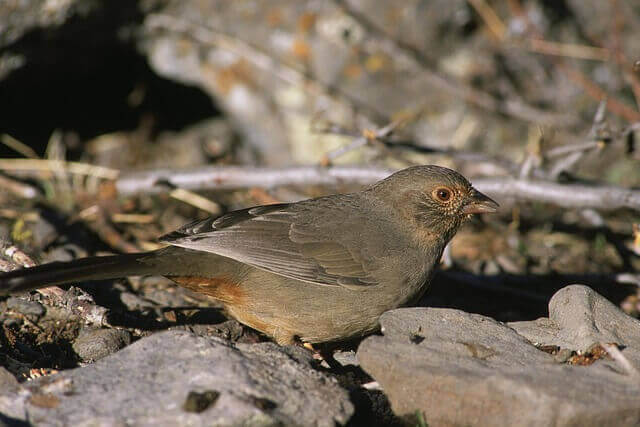
The California Towhee is a medium-sized bird that resides in the western United States. The distribution range of the California Towhee stretches across the Western United States, including Washington, Oregon and Northern California. They are also found in Mexico and Canada, as well as Central America. This species, which can be seen throughout the state (including Los Angeles and San Diego).
It lives mostly in coastal scrub and chaparral habitats, but it can also be found in other open, brushy areas such as suburban gardens. It eats insects (mostly beetles), seeds, berries and some fruit year-round. During the winter, it also feeds on pine nuts found on cones of coniferous trees that have dropped their seeds.
- Frequency: 28.91%
- Color: Mainly brown with a reddish-brown under tail.
- Habitat: Brush, chaparral, urban parks and gardens
- Range: Coastal areas of western Oregon, Baja California, Mexico.
- Size: 7.9″ – 9.8″ inches long
- Weight: 48.5 – 61.1 grams
- Diet: Seeds of weeds, grasses, waste grain. Also eats insects berries and fruits.
- Family: Passerellidae
- Genus: Melozone
- Maps: Range Map – Sightings Map
- Sounds: Calls and Songs
Related: How to Attract Towhee to your Backyard? Expert Tips!
Common Raven
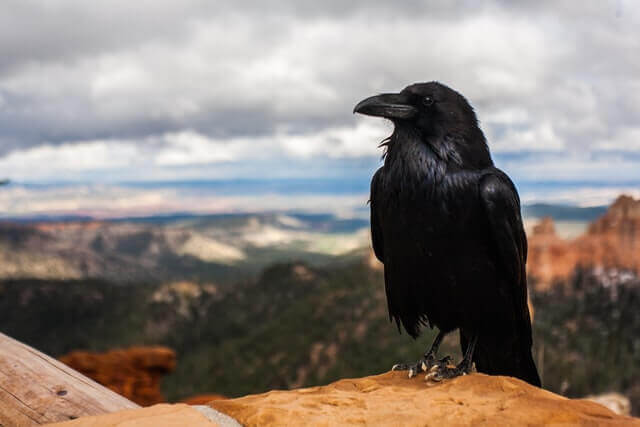
The Common Raven has a wide distribution across the North American continent, is a common large all-black passerine bird with a large body, strong beak, and distinctive black body. Found throughout the Northern Hemisphere, it is probably the most common of all corvids living in the habitats they inhabit.
They tend to live near ponds and creeks and have been shown to be attracted to trash and garbage. These birds usually return to the same spot each year, except in southern climates where they may move a few hundred miles south.
- Frequency: 27.86%
- Color: All black iridescent plumage
- Habitat: Wooded areas, evergreen forests, tundra, roadside, grasslands, backyards, parks
- Range: Found throughout the Northern Hemisphere
- Size: 21 – 26 inches long
- Weight: 1.5 – 4.5 lbs.
- Diet: Mainly scavengers, feeding on carrion, beetles, and maggots.
- Family: Corvidae
- Genus: Corvus
- Maps: Range Map – Sightings Map
- Sounds: Calls and Songs
Song Sparrow
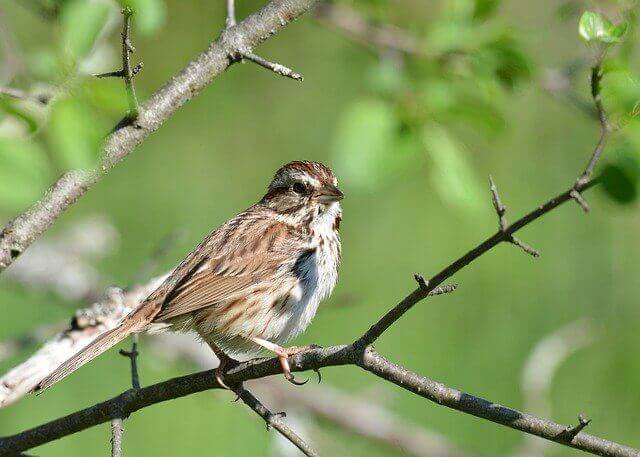
The song sparrow’s range includes the eastern half of North America, from southern Canada to Florida in the U.S., Central America and much of South America east of the Andes Mountains. This particular species prefers habitats with open space for it to land on, such as grasslands, brushy areas or fields.
Song sparrows have a diet consisting mostly of insects and berries. They are also known to eat worms, grasshoppers, crickets, spiders and even small rodents when they find them on the ground. Song sparrows are mostly migratory birds which travel south during winter months when there is little food available north of their range.
- Frequency: 27.49%
- Color: Gray head, white cheek, a black bib, rufous neck
- Habitat: Urban centers, farms, backyards, edges, yards, and parks
- Range: Europe, Mediterranean, Asia, Australasia, Africa, and the Americas
- Size: 5.5 – 7.0″ inches
- Weight: 25 – 40 grams
- Diet: Grains, seeds, and insects
- Family: Passeridea
- Genus: Passer
- Maps: Range Map – Sightings Map
- Sounds: Calls and Songs
Related: How to Attract Sparrows to your Backyard
Lesser Goldfinch
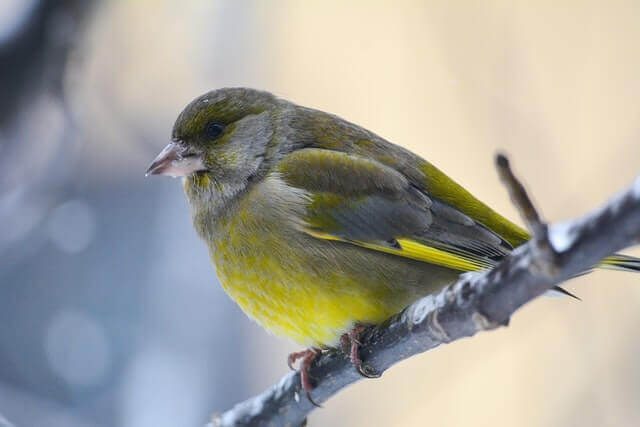
The Lesser Goldfinch is a small songbird in the finch family, Fringillidae. The bird has a very limited range and habitat, mostly found in Southern Arizona and New Mexico, where it lives in shrubs near water sources in forests and wetlands for nesting grounds; coniferous trees for feeding; open grasslands or agricultural fields.
Lesser Goldfinches have an insectivorous diet consisting mainly of seeds, grain products like corn and wheat, as well as berries. This species of bird is migratory, traveling north in the summer to avoid extreme heat and south in winter for breeding purposes.
- Frequency: 25.90%
- Color: Bright yellow underparts, white patches on the tail and wings
- Habitat: Almost any habitat with trees or shrubs, backyards
- Range: Southwestern United States, Washington, Peru, Venezuela
- Size: 3.5 – 4.7″ inches long
- Weight: 8 – 12 grams
- Diet: Tree buds and weed seeds
- Family: Fringillidae
- Genus: Spinus
- Maps: Range Map – Sightings Map
- Sounds: Calls and Songs
European Starling
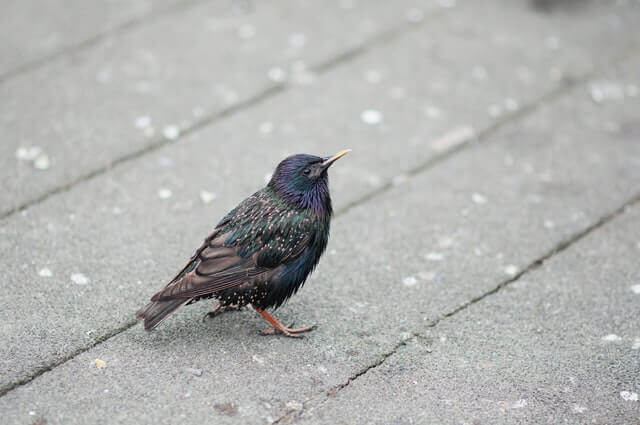
The European Starlings are a large and abundant species of bird that lives in Europe, Asia, Africa and Australia. Their habitat ranges from tropical to temperate climates. They have been introduced into North America and New Zealand as well. They are mainly found near wetlands and marshes, but they can also be seen in rural areas such as farmlands.
European Starlings typically eat invertebrates such as spiders, earthworms, insects or snails which they find on the ground or scavenge for dead animals. They also eat fruit such as berries if it is available. Some migrate south during winter while others stay in northern climates all year round, but they all fly at nighttime for safety reasons.
- Frequency: 24.62%
- Color: Black with glossy iridescence plumage
- Habitat: Forests, woodlands, backyards, edges, yards, and parks
- Range: North America, Europe, Africa, India, Middle East, China
- Size: 7 – 9″ inches long
- Weight: 60 – 100 grams
- Diet: Insects (ants, beetles, invertebrates), fruits, seeds, berries
- Family: Sturnidae
- Genus: Sturnus
- Maps: Range Map – Sightings Map
- Sounds: Calls and Songs
Related: How to Attract European Starlings to your yard?
Bushtit
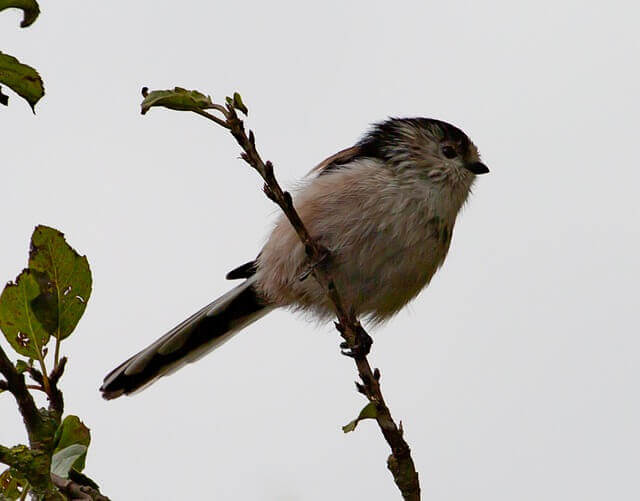
The Bushtit has a varied distribution across the country. It is found primarily in the Eastern Slope, but is also found in scattered populations in Central and Southern California. The most common color variation found in this species is gray.
A favorite food source for the long-tailed tits is the leaf litter of conifers. They also eat berries, suet, and seeds, although these foods are quite diverse and may be consumed by other birds. Hanging nests are the preferred habitat for these birds, which are also found on wood, plants, and grass. Bushtit birds are not generally aggressive but are wary of humans.
- Frequency: 22.83%
- Color: Dull gray or brown
- Habitat: Forest edge and understory habitats, yards, and parks
- Range: Western North America
- Size: 3.5″ – 5.5″ inches long
- Weight: 4.5 – 9 grams
- Diet: Insects
- Family: Aegithalidae
- Genus: Psaltriparus
- Maps: Range Map – Sightings Map
- Sounds: Calls and Songs
Dark-eyed Junco
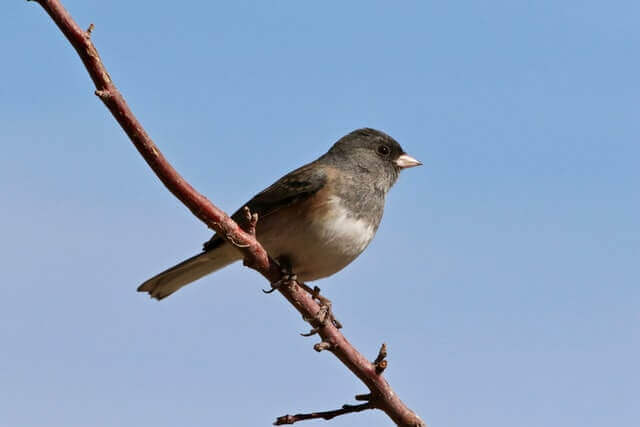
The Dark-eyed Junco is a species of bird that can be found in North America. They live in habitats such as deciduous forests, mixed coniferous and deciduous forests, or the edges of open woodlands. The Dark-eyed Junco ranges from Alaska to southern Mexico and from central Canada to Central America.
It migrates during winter, which could range anywhere between September and April depending on the region it lives in. The diet of this species includes mostly seeds and other plant matter, as well as some insects such as caterpillars or spiders.
- Frequency: 21.89%
- Color: Gray head, neck, breast, gray/brown backs and wings, white underside
- Habitat: Wooded areas, forest edges, roadsides, gardens, parks.
- Range: USA and Canada
- Size: 5.1 – 6.9″ inches
- Weight: 18 – 30 grams
- Diet: Seeds, insects, and arthropods
- Family: Passeriformes
- Genus: Junco
- Maps: Range Map – Sightings Map
- Sounds: Calls and Songs
Related: Fun Facts about Dark-eyed Juncos
Spotted Towhee
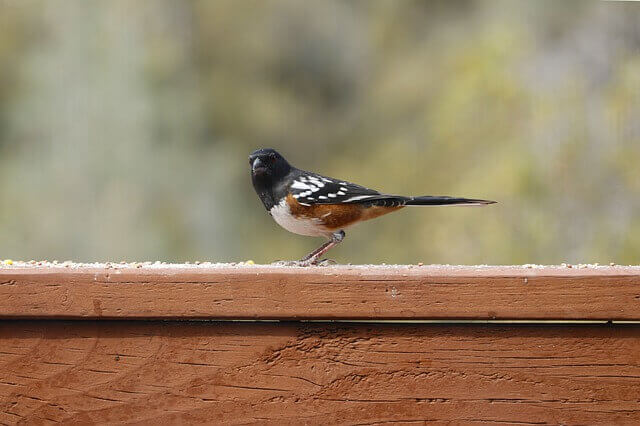
The spotted towhees are thought to have originated along the east coast of North America and to have later spread over northern Mexico and the southwestern United States. Facts show that they occur on a large variety of plant and tree leaves from all parts of the world. They are commonly seen in parks, trails, swamps, near lakes, and backyards where they can be seen lurking around waiting for insects or birds to pass by.
Like all songbirds, the spotted towhee needs a lot of room to fly around. They have thick, bills that are equipped with sharp claws, making them excellent candidates for eating a range of insects, including mosquitoes, spiders, dragonflies, wasps. They are extremely social birds, with pairs and even family groups nesting in nest boxes and washing rooms of various shrubs and trees where they look for food and cover.
- Frequency: 21.19%
- Color: Dark head, upper body, tail and a white belly, white spots on the back, white wing bars, rufous sides
- Habitat: Wooded areas, forest edges, roadsides, gardens, parks.
- Range: USA and Canada
- Size: 6.7 – 8.3″ inches
- Weight: 33 – 49 grams
- Diet: Spiders, insects, and arthropods
- Family: Passerellidae
- Genus: Pipilo
- Maps: Range Map – Sightings Map
- Sounds: Calls and Songs
Northern Mockingbird
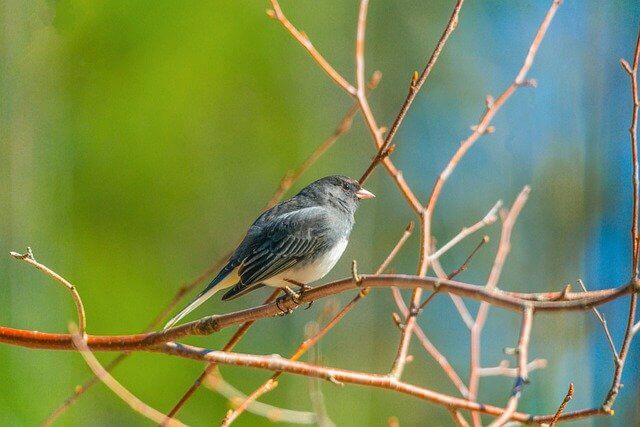
The Northern Mockingbird can be found in a variety of places across the northern United States. These birds have also made a few appearances in Canada. This species is particularly popular in dense forests, as their population densities tend to be quite large. Mockingbirds also use nests of a variety of different trees, including elms, maples, oaks, walnuts, and birch trees. The nests are constructed from pine cones, twigs, leaves, fruits, and seeds. They can even be found underneath decks and on porches.
Unlike most other species of the mockingbird family, the Northern Mockingbird does not have a specialized habitat but instead makes its home in an array of different habitats across the continent. They can be found in wooded areas, mixed forests, and open areas. Some of the more common natural habitats for the species found in the lower 48 states include coastal sagebrush terrains, back-woods areas, evergreen shrubs, and rocky cliffs. Mockingbirds are particularly adept at mimicking the sounds of other birds.
- Frequency: 20.93%
- Color: Gray upper with white underparts. Black and white wing bars.
- Habitat: Forested areas, parks, and gardens
- Range: Southeastern Canada, USA, Northern Mexico, Cayman Islands, Greater Antilles
- Size: 8.0 – 11″ inches long
- Weight: 40 – 58 grams
- Diet: Berries, fruits, seeds, arthropods, earthworms, and occasionally lizards
- Family: Mimidae
- Genus: Mimus
- Maps: Range Map – Sightings Map
- Sounds: Calls and Songs
Related: How to Attract Mockingbirds to your Yard? (Expert Tips)
American Robin

The American Robin is a regular migratory bird of the true thrush genre and Turdidae. They eat all kinds of berries, leafy vegetables, insects, seeds, and, of course, berries themselves, but they particularly enjoy eating the red berries. In fact, the American Robin is one of the bird families that are known for their appetites, and they love to eat just about anything that is sugary.
The male American Robin is not very agile, but he is quite capable of flight, and he usually flies alone. He loves to forage on the ground and generally remains in a roosting area, looking for food all day long. Other birds and sometimes even cats may try to get into his roosts, but they are usually repelled by his powerful wings and beak.
- Frequency: 19.96%
- Color: Mostly brown on the back with an orange colored breast
- Habitat: Wooded areas, backyards, parks, fields
- Range: USA, Canada, Mexico
- Size: 12 – 16″ inches
- Weight: 72 – 95 grams
- Diet: Fruits, berries and insects (earthworms, beetles, caterpillars
- Family: Turdidae
- Genus: Turdus
- Maps: Range Map – Sightings Map
- Sounds: Calls and Songs
Related: Interesting American Robin Fun Facts
Bewick’s Wren
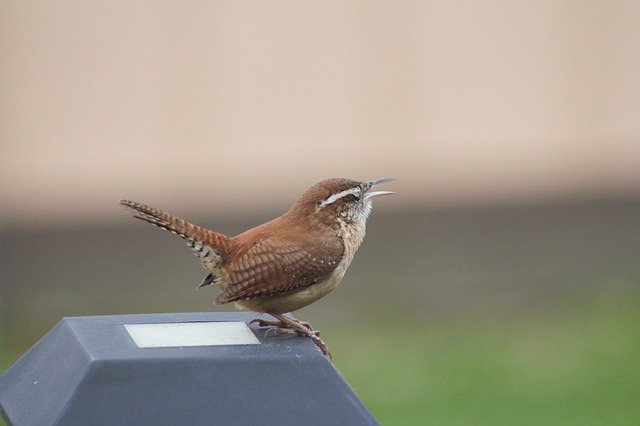
The Bewick’s wren is a beautiful wren species native to North America. At around 14 cm long, it’s gray-white on top, white below, with extremely long white eyebrows. While very similar in look to the Carolina wren, it has a much longer tail that is nearly tip upwards. The song is also rather melodic and loud, much like that of other wrens.
This wren is not only found in North America but has also been recorded in the southern portions of Venezuela and Cuba. Its range extends into Mexico, and birds have been noted from the Gulf of Mexico, northern portions of Nicaragua, and the Yucatan Peninsula. During the breeding seasons, these wrens become more active and show up in flocks as well as flocks of several birds at once.
- Frequency: 18.54%
- Color: Gray-brown on top, white underneath, with a long white eyebrow.
- Habitat: Open woodlands, thickets, brush piles, hedgerows, near streams.
- Range: British Columbia, southern Ontario, Nebraska, Southwestern Pennsylvania, Maryland, Arkansas, and also in the northern Gulf States.
- Size: 5.5″ inches
- Weight: 9.8 grams
- Diet: Seeds, berries, and insects including beetles, ants, wasps, true bugs, caterpillars, grasshoppers
- Family: Troglodytidae
- Genus: Thryomanes
- Maps: Range Map – Sightings Map
- Sounds: Calls and Songs
Related: How to Attract Wrens to your Backyard? (Expert’s Guide)
Northern Flicker
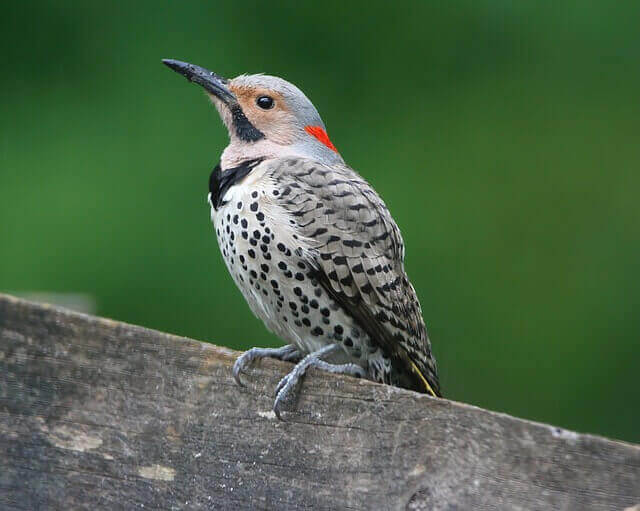
The Northern Flicker is a large-sized woodpecker of the small woodpecker group. It’s native too much of North America, as well as parts of Central America, Cuba, and even the Cayman Islands. The flickers are, often between 10 – 14″ inches long overall, and have powerful bills that help them scrape insect prey from tree trunks.
They are seldom seen in the wild, but have been known to be caught on camera a few times, often flitting through the woods with a quick and energetic pace.
- Frequency: 18.37%
- Color: Light brown with black bars across back, chest, wings, belly
- Habitat: Forests, woodlands, backyards, edges, yards, and parks
- Range: North America, Central America, Cuba, Cayman Islands
- Size: 10 – 14″ inches
- Weight: 85 – 165 grams
- Diet: Insects (ants, beetles, invertebrates), fruits, seeds, berries
- Family: Picadae
- Genus: Colaptes
- Maps: Range Map – Sightings Map
- Sounds: Calls and Songs
Related: How to Attract Northern Flickers to your Backyard
The backyard birds below have a frequency of less than 18%
- Nuttall’s Woodpecker – 17.55% Frequency
- Red-winged Blackbird – 17.33%
- Ruby-crowned Kinglet – 16.32%
- Acorn Woodpecker – 15.86%
- Oak Titmouse – 15.54%
- Killdeer – 15.22%
- House Sparrow – 14.65%
- Brewer’s Blackbird – 14.57%
- Western Bluebird – 14.14%
- Golden-crowned Sparrow – 13.46%
- Eurasian Collared-Dove – 13.37%
- Pied-billed Grebe – 12.91%
- Chestnut-backed Chickadee – 12.79%
- Orange-crowned Warbler – 12.53%
- American Kestrel – 11.85%
- Steller’s Jay – 11.73%
- California Quail – 11.38%
- Common Yellowthroat – 11.35%
- Wrentit – 10.49%
- Barn Swallow – 10.16%
Frequently Asked Questions
Are there falcons in Los Angeles?
Falcons are often seen in California, but not many people know where to spot them. There are three spots where you can see these majestic birds around the city of Los Angeles – Griffith Park, Santa Monica Pier and Venice Beach. They can be found perched on telephone poles, power lines, and rooftops.
What is the official bird of California?
The California Quail was announced the official state bird in 1931. It is a member of the grouse family and was once common throughout the state. Now it is mainly found in southern California and northern Baja, Mexico.
Are There robins in Southern California?
Robins are one of the most common birds in Southern California. They are seen at a 19.5% frequency and can be found from San Diego to Santa Barbara County.
Do cardinal birds live in California?
Cardinal birds are not native to California. They live in the Eastern United States and Canada. It is possible that they migrated from their home to California, but it is a very rare sight for these birds with only 0.03% frequency in the state of California. There have been sightings Irvine Regional Park and Crystal Cove State Park.
Is there blue Jays in California?
Blue Jay birds are a species of bird that is native to the eastern part of North America. California is not located in the Eastern part of North America, so it does not have Blue Jays.
What is the most common bird in southern California?
According to Ebird, the most common bird in southern California is the House Finch, with a 46 percent frequency. The House Finch is a small bird, measuring about 5-6 inches in length. It has a brown body with streaked feathers, and a red head and breast. The House Finch can be found in woodlands, parks, and suburbs. It feeds on seeds, fruits, and insects.
What are the bluebirds in California called?
The bluebirds in California are called Western Bluebird and Mountain Bluebird. The Western Bluebird is a small bird with blue upper parts and a rusty breast. They are found in open areas such as meadows, parks, and gardens. The Mountain Bluebird is about the same size as the Western Bluebird, except it has a lighter blue plumage. They are found in mountainous regions and nest in cavities.



